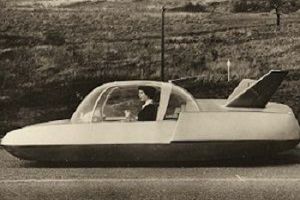The Simca Fulgur (fulguris Latin for “flash”) is possibly the silliest concept car of the 1950s. But that wasn’t surprising-the project was a fantasy car of the year 2000, created with suggestions from young readers of a French children’s magazine.

Simca Fulgur 1959
- YEAR REVEALED 1959
- PLACE OF ORIGIN Paris, France
- HISTORICAL STATUS prototype
- ENGINE none fitted, but intended for an electric engine
- MAXIMUM POWER unknown
- LAYOUT rear-mounted engine driving the rear wheels
- BODYWORK canopy-entry, two-seater coupé
- TOP SPEED unknown
- NUMBER BUILT one
Had it ever worked as the children intended, it would have been electrically driven, taking its power from a live rail buried in the road surface. When the Fulgur’s speed reached 90mph (145kph), its two front wheels would retract into the body so that it would, somehow, plane along on its rear two wheels, steered by rudders.
Fortunately, however, an on-board gyroscope would make sure the car tracked upright and stably. A fiendish combination of radar and a computer, or “electronic brain” as Simca preferred to call it, would look after navigation. And it had the obligatory 1950s dream car feature: a huge tailfin (in this case V-shaped). Although there were doubts about how all this untried technology would actually function, the Fulgur went down a storm at the 1959 Geneva Motor Show, and was still a crowdpuller when it appeared at the Chicago Auto Show in 1961.
The most significant thing about the Fulgur was the man who designed the static mock-up, 27-year-old architect Robert Opron. Although he was made redundant from Simca’s styling department in 1961 (spending two years designing fridges and stoves), he returned to the car industry and was responsible for the acclaimed looks of the Citroen SM and the Renault Fuego.